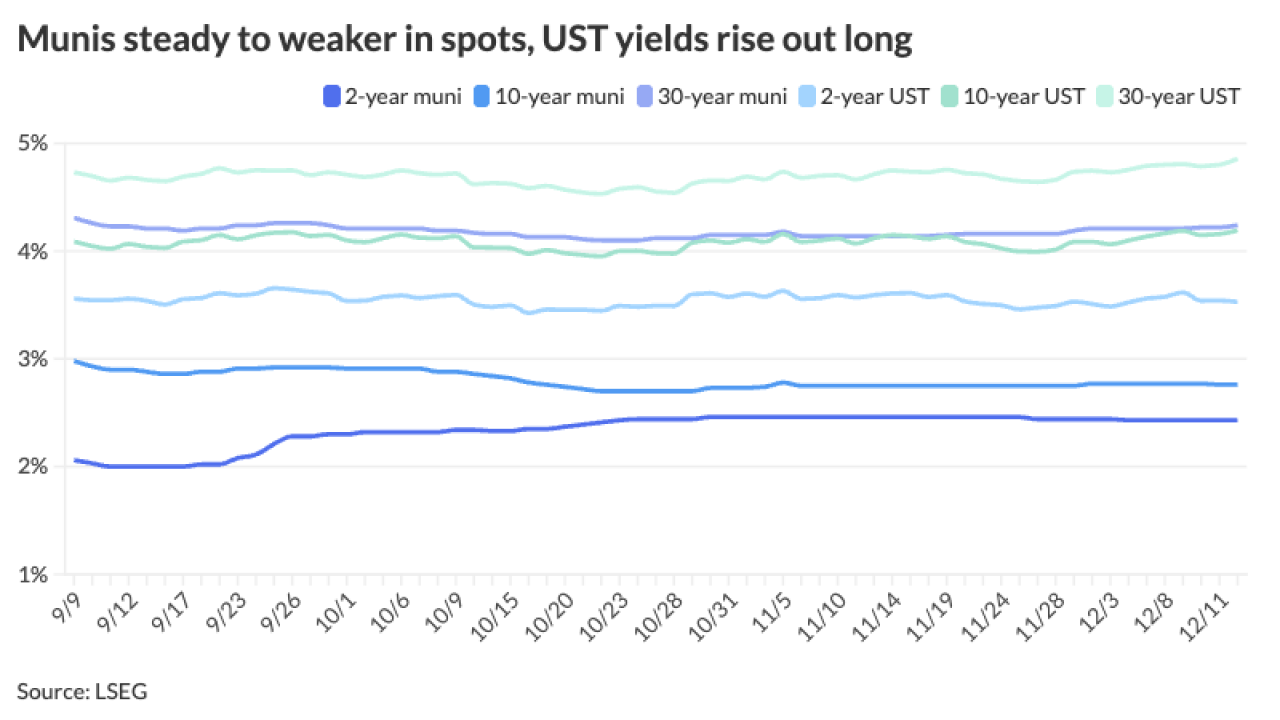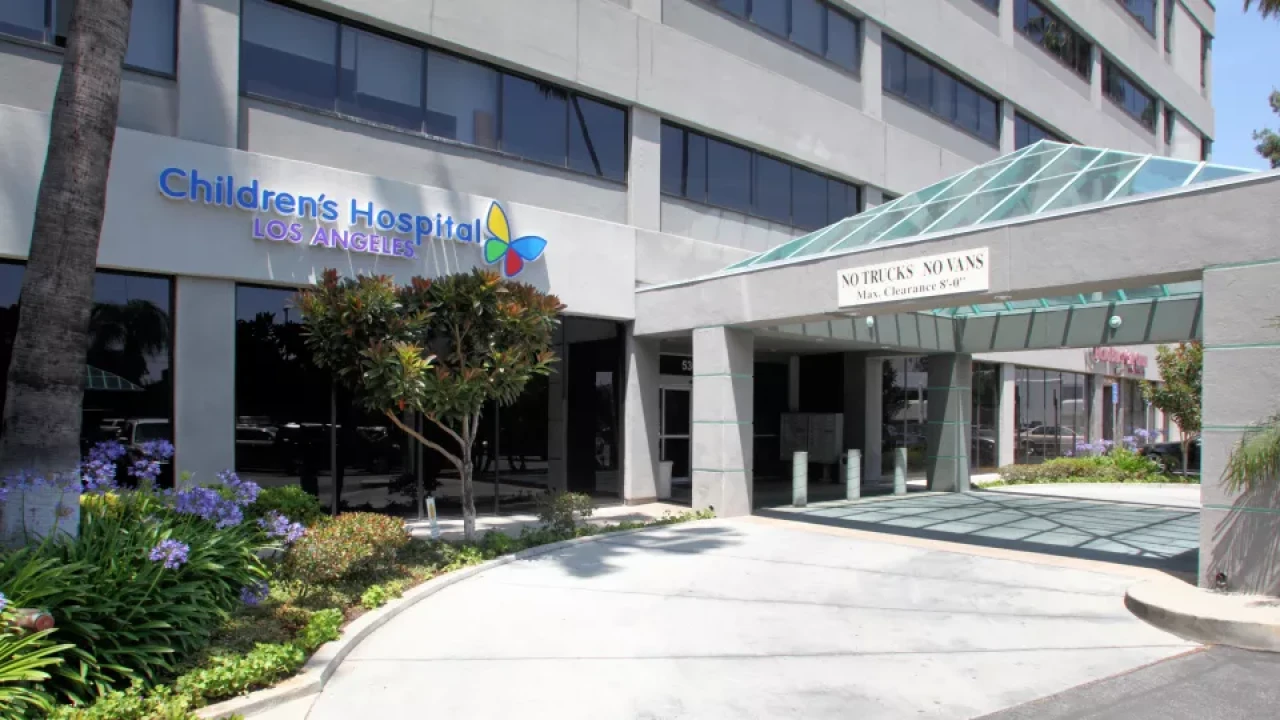Municipals were slightly firmer to kick off the second half of the year, as U.S. Treasury yields rose and equities ended mixed.
The two-year muni-UST ratio Tuesday was at 67%, the five-year at 68%, the 10-year at 76% and the 30-year at 95%, according to Municipal Market Data's 3 p.m. ET read. ICE Data Services had the two-year at 66%, the five-year at 70%, the 10-year at 75% and the 30-year at 94% at 4 p.m.
Despite continued heavy new issue volume, July is shaping up to be another positive month for the municipal bond market.
The muni market saw returns of 0.62% in June, paring the market's year-to-date losses to negative 0.35%, said Jason Wong, vice president of municipals at AmeriVet Securities.
That stands in "stark contrast to the prior month of May, in which munis were flat for the month, and a complete 180 from the month of April, when we experienced losses of 0.81%," he said.
"Munis are starting to slowly crawl out of the red, as we were down 2.78% back in April when tariffs were put in place, which sent the markets into a frenzy," Wong said. "Since then, we have rallied, with yields bumping by an average of 29.7 basis points."
Muni yields rose by an average of 7.6 basis points across the curve in June, he said, with yields on 10-year notes rising by 10.7 basis points. However, "munis did underperform versus Treasuries, as the 10-year ratio is now yielding 75.83% compared to 75.24% at the start of the month," he noted.
"We should continue to see supply surge for the second half of the year as borrowers will start to issue more debt once the Fed cuts rates," Wong predicted. "We could see more of a surge in issuance in some ESG projects if the Trump administration eliminates some federal programs."
However, demand looks to be strong enough to absorb that volume.
Inflows slowed in June to $1.14 billion, down from $3.16 billion in May, according to LSEG.
Second quarter outflows totaled $1.1 billion, mainly in April "due to rising rates and the announcement and imposition of tariffs, which sparked a sell off" Wong said.
Muni mutual funds have added about $4.36 billion since the start of this year, according to LSEG.
Looking ahead, "munis should be able to continue June's rally as the month of July has been a historically positive month, with 11 straight years of positive gains since 2014," Wong said. "With Treasury yields continuing to fall, inflation readings pushing for a rate cut, as well as stronger than expected technicals, munis should continue their rally.
"With July being a slow month for issuances, demand should continue to remain high as investors are likely to continue to take advantage of higher yields and well as cheaper bonds when compared to Treasuries," Wong said.
J. Robert Lind of Lind Capital Partners is advising investors to take advantage of the expected lull in new issuance.
"We are entering a period during the summer months in which demand historically outweighs very limited supply, resulting in a supportive performance environment but more limited investment opportunities," he said.
"This is an excellent time for investors to start making portfolio adjustments or taking care of operational tasks to prepare to deploy new capital during the most attractive purchasing period, historically, between Labor Day and yearend," Lind said. "Advisors can take advantage of summer meetings to have conversations with their clients about making decisions ahead of Q4."
While "we believe these historical trends are likely to continue this year," Lind added "one caveat" to this scenario.
"Over the past few months, we have seen heavy new issue supply, which has caused many new deals to be postponed after failing to gather sufficient investor appetite," he said. "After market participants return from Fourth of July week vacations, we expect healthy volume will also return."
With a higher-than-normal supply, Lind expects to see "increased market activity and more opportunities than historical trends would suggest. So, while preparing for the Q4 buying environment is still a prudent use of time, opportunistic investors with capital ready to deploy could take advantage of a few 'bonus' weeks of investment opportunity in July this year. While the primary market will understandably slow down ahead of Independence Day, the forward calendar continues to build in July, indicating continued opportunity."
In the primary Tuesday, Ramirez priced for Quincy, Massachusetts, $337.8 million of general obligation bond anticipation notes as 5s to yield 3.00% in 7/2026.
Wells Fargo Bank priced $158.38 million of University of Cincinnati (Aa3/AA-) Series 2025A general receipts bonds. The issue was priced as 5s to yield 4.09% in 6/2039, 5s to yield 4.17% in 6/2040, 5.25s to yield 4.59% in 6/2045, and 5.25s to yield 4.80% in 6/2049.
AAA scales
MMD's scale was bumped 11 years and in: The one-year was at 2.54% (-3, no July roll) and 2.55% (-3, no July roll) in two years. The five-year was at 2.63% (-4, no July roll), the 10-year at 3.25% (-1, no July roll) and the 30-year at 4.54% (unch) at 3 p.m.
The ICE AAA yield curve was bumped up to two basis points: 2.56% (-2) in 2026 and 2.48% (-2) in 2027. The five-year was at 2.64% (-2), the 10-year was at 3.16% (-1) and the 30-year was at 4.48% (unch) at 4 p.m.
The S&P Global Market Intelligence municipal curve was bumped up to three basis points: The one-year was at 2.54% (-3) in 2025 and 2.55% (-3) in 2026. The five-year was at 2.63% (-3), the 10-year was at 3.24% (-1) and the 30-year yield was at 4.53% (unch) at 4 p.m.
Bloomberg BVAL was bumped one to two basis points: 2.55% (-2) in 2025 and 2.57% (-2) in 2026. The five-year at 2.67% (-2), the 10-year at 3.17% (-2) and the 30-year at 4.46% (-1) at 4 p.m.
Treasuries saw losses.
The two-year UST was yielding 3.78% (+6), the three-year was at 3.749% (+6), the five-year at 4.841% (+4), the 10-year at 4.254% (+2), the 20-year at 4.784% (+1) and the 30-year at 4.779% (flat) just before the close.





